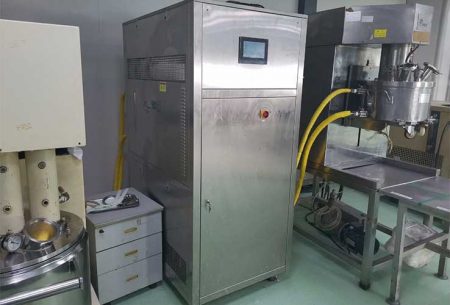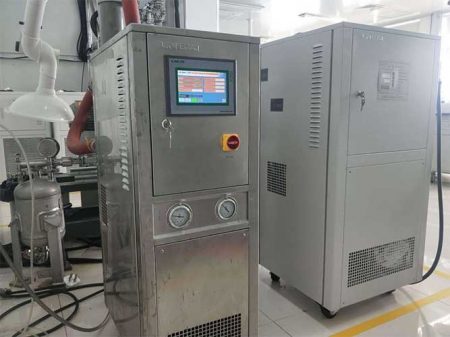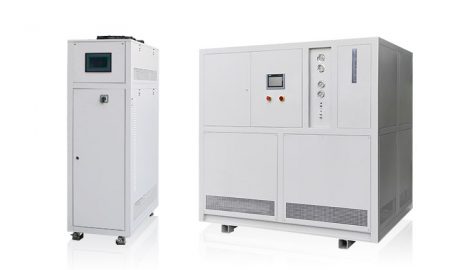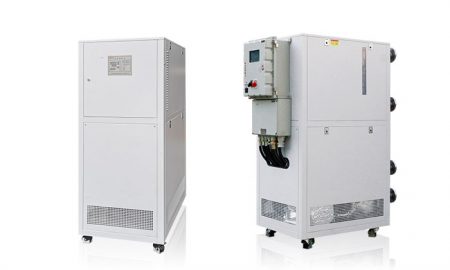Best Cooling and Heating System for Chemical
The cooling and heating system for chemical uses the refrigeration system to cool the liquid medium below the set temperature, and then transports the medium to the equipment that needs to be controlled, and raises or lowers the temperature of the equipment to the required temperature range through heat exchange. When the equipment reaches the required temperature, the refrigeration system stops working, and the medium is returned to the refrigeration system for heating or cooling for the next use.

Installation steps of cooling and heating system for chemical
1. Choose a suitable installation location: It should be installed in a well-ventilated, dry, dust-free, and corrosive gas-free environment. At the same time, the equipment should be protected from direct sunlight and rain.
2. Connect the power supply: Connect the power cord to the power socket that meets the requirements of the device. Ensure that the power supply voltage is stable to avoid damage to equipment caused by voltage fluctuations.
3. Connect the cooling water system: Connect the water inlet and outlet to the cooling water system. Make sure the cooling water pressure and flow rate meet equipment requirements.
4. Connect the heat exchanger: Connect the heat exchanger to the medium pipe that needs to be heated or cooled. Make sure the pressure and flow rate of the medium meet the equipment requirements.

Debugging steps for cooling and heating system for chemical
1. Check the equipment: Before starting, check whether the appearance of the equipment is damaged, whether the components are firmly installed, and whether the power cord is connected correctly.
2. Set temperature: Set the target temperature according to test requirements. Note that the target temperature should be within the device’s operating temperature range.
3. Start the device: Turn on the power switch and the device starts running. At this time, the operating status of the equipment should be closely observed, and if there is any abnormality, it should be stopped immediately for inspection.
4. Adjust parameters: During the operation of the equipment, timely adjust the parameters of the equipment, such as temperature, pressure, flow, etc., according to actual test requirements.
5. Check the equipment performance: After the equipment has been running for a period of time, check whether the performance of the equipment meets the test requirements. If there are problems, adjustments should be made in time.
Precautions for cooling and heating system for chemical
1. Installation and debugging should be carried out by professionals to prevent equipment damage or personal injury caused by improper operation.
2. During the operation of the equipment, regular maintenance and inspections should be carried out to ensure the normal operation of the equipment.
3. When the equipment fails, it should be stopped immediately and inspected and repaired by professionals.
Correo electrónico: info@lneya.com WeChat ID: +8615251628237 WhatsApp: +86 17851209193

Sistemas de refrigeración y calefacción (serie SUNDI)
Rango de control de temperatura: -120°C a +350°C
Application: Various Reactors (Microchannels, Glass, Jacketed Reactors, etc.), Distillation or Extraction System, Laboratory, University, Research Institute, Aerospace, Automotive Industry, Semiconductor and Electrical Test, Chemical, Pharmaceutical, Petrochemical, Biochemical, Medical, Hospital, R&D Workshop, Aerospace, Biological and Other Industries.
| Temperatura | Serie -10 ~ +150°C | Serie -25 ~ +200°C | Serie -25 ~ +300°C | Serie -45 ~ +250°C | Serie -45 ~ +300°C | Serie -60 ~ +250°C | Serie -60 ~ +300°C | Serie -70 ~ +250°C | Serie -80 ~ +250°C | Serie -90 ~ +250°C | Serie -100 ~ +100°C | ||
| Capacidad de refrigeración | 1,5 ~ 15 kW | 1 ~ 200 kW | 1 ~ 200 kW | 0,45 ~ 200 kW | 0,9 ~ 25 kW | 0,25 ~ 60 kW | 0,75 ~ 25 kW | 0,4 ~ 15 kW | 0,3 ~ 80 kW | 0,2 ~ 80 kW | 0,45 ~ 80 kW | ||
| Nota: Se puede personalizar cualquier rango de temperatura de -150℃ ~ +350℃ y cualquier capacidad de refrigeración. | |||||||||||||

Sistemas de refrigeración y calefacción (serie WTD)
(Microcanales / reactores tubulares especializados)
Rango de control de temperatura: de -70°C a +300°C
Diseño especializado para microcanal (pequeña capacidad de retención de líquido, gran capacidad de intercambio de calor, sistema de circulación de alta caída de presión)
| Temperatura | -70°C ~ +300°C | -45°C ~ +250°C | -70°C ~ +200°C | ||||||
| Capacidad de refrigeración | 1,1 ~ 7,5 kW | 1,5 ~ 5,5 kW | 11 ~ 50kW | ||||||
| Nota: Se puede personalizar cualquier rango de temperatura de -150℃ ~ +350℃ y cualquier capacidad de refrigeración. | |||||||||

Circuladores de refrigeración y calefacción
Rango de control de temperatura: -45°C a +250°C
Application: Various Reactors (Microchannels, Glass, Jacketed Reactors, etc.), Distillation or Extraction System, Laboratory, University, Research Institute, Aerospace, Chemical, Pharmaceutical, Petrochemical, Biochemical, Medical, Hospital, R&D Workshop, Aerospace, Biological and Other Industries.
| Temperatura | Serie -25°C ~ +200°C | Serie -45°C ~ +250°C | |||||||
| Capacidad de refrigeración | 1 ~ 15 kW | 0,25 ~ 15 kW | |||||||
| Nota: Se puede personalizar cualquier rango de temperatura de -150℃ ~ +350℃ y cualquier capacidad de refrigeración. | |||||||||

Termostatos de circulación
Rango de control de temperatura: +50°C a +300°C
Nota: La serie UC puede controlar la temperatura del medio de transferencia de calor. La serie UST no solo puede controlar la temperatura del medio de transferencia de calor, sino también la temperatura del material de reacción.
| Temperatura | +50°C ~ +170°C (serie UC) | +50°C ~ +300°C (serie UC) | +50°C ~ +300°C (serie UST) | ||||||
| Capacidad de calefacción | 5,5 ~ 15 kW | 3,5 ~ 130 kW | 3,5 ~ 95 kW | ||||||
| Nota: Se puede personalizar cualquier rango de temperatura de -150℃ ~ +350℃ y cualquier capacidad de refrigeración. | |||||||||
 LNEYA
LNEYA
 简体中文
简体中文


















































































